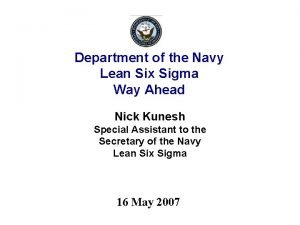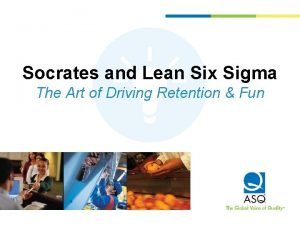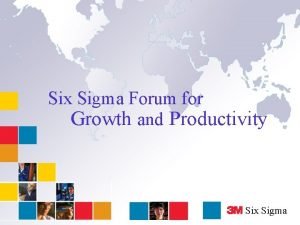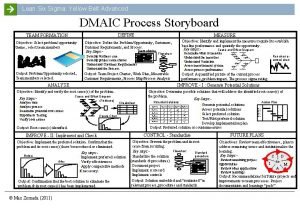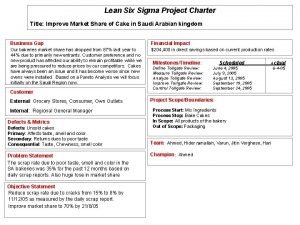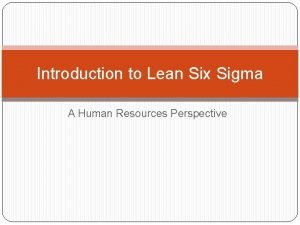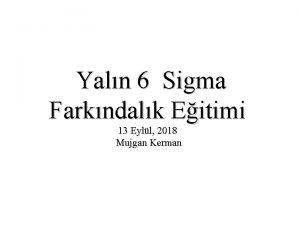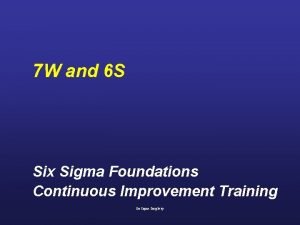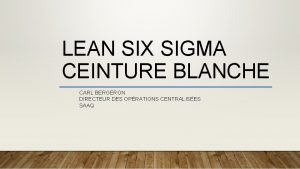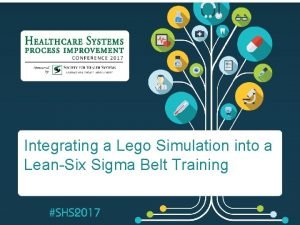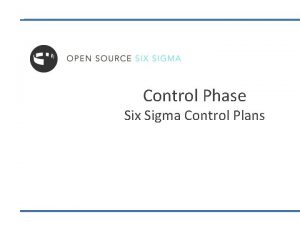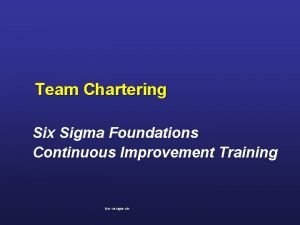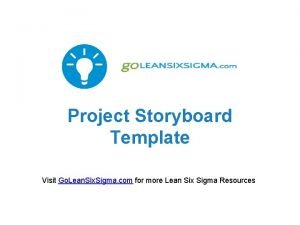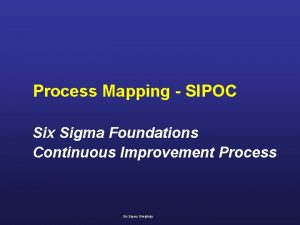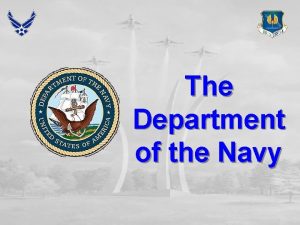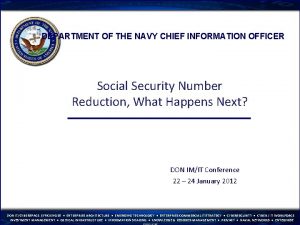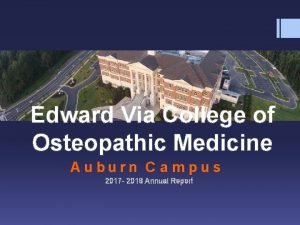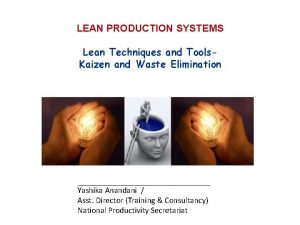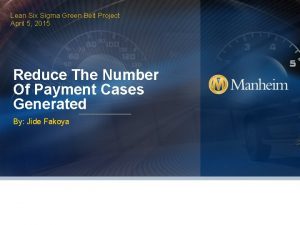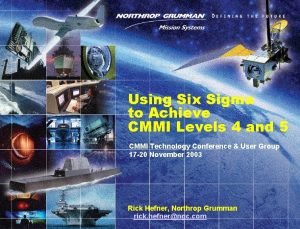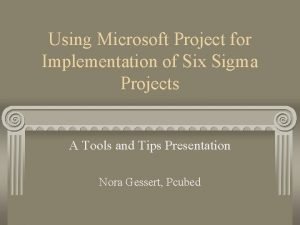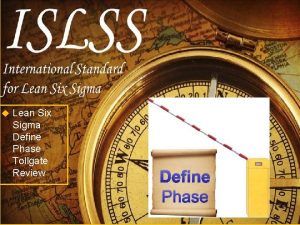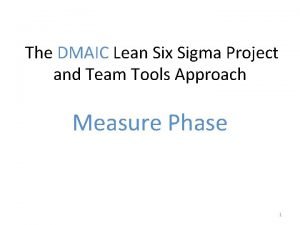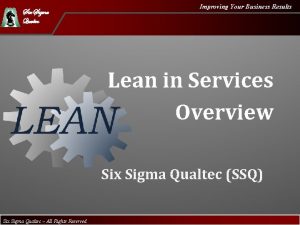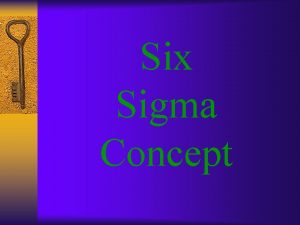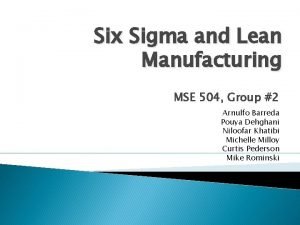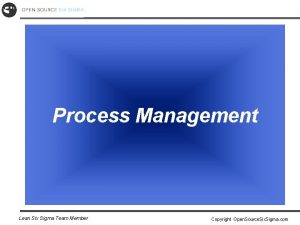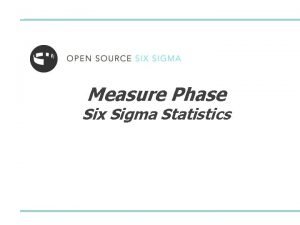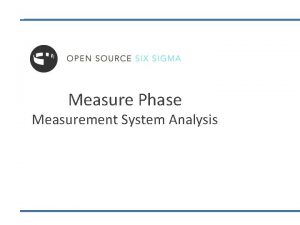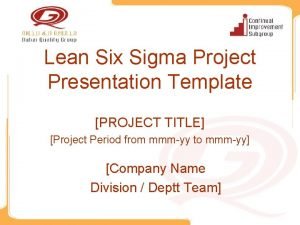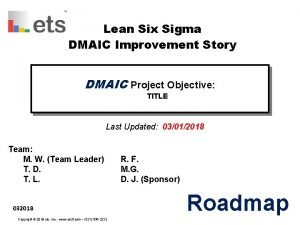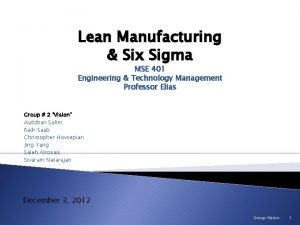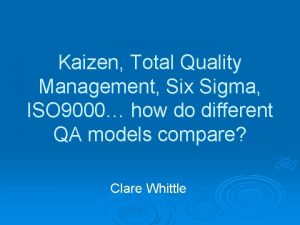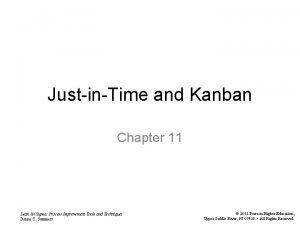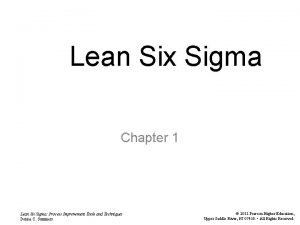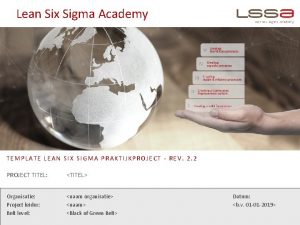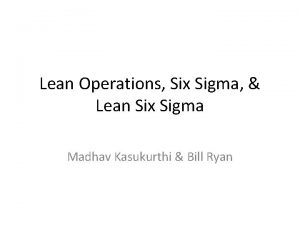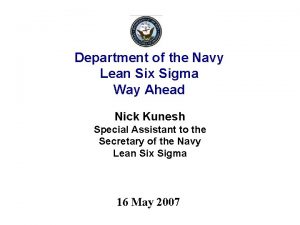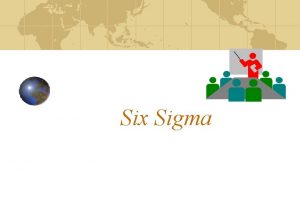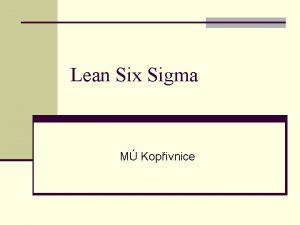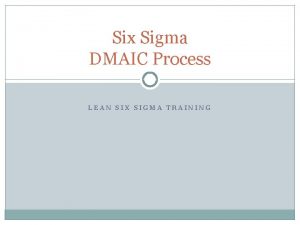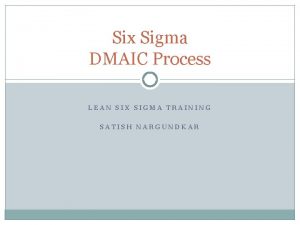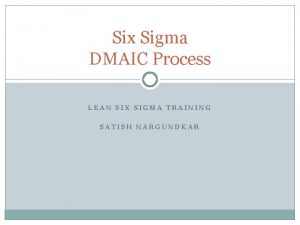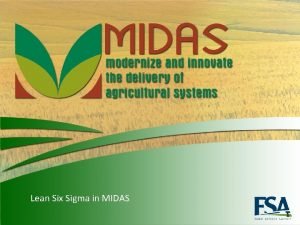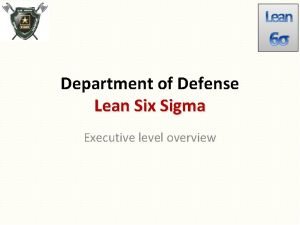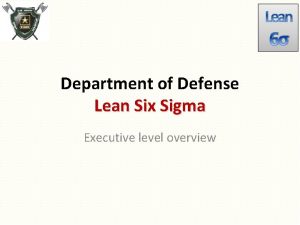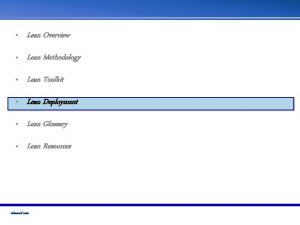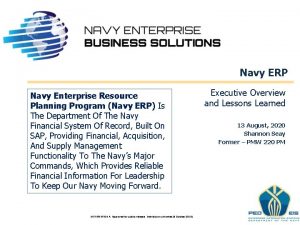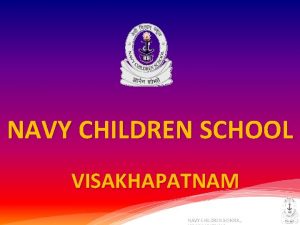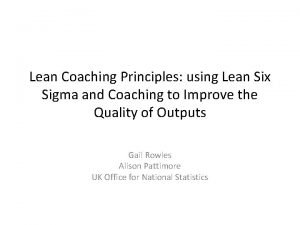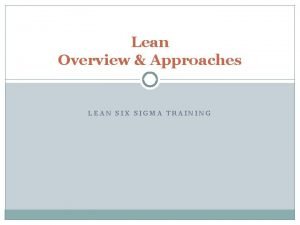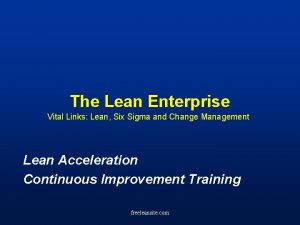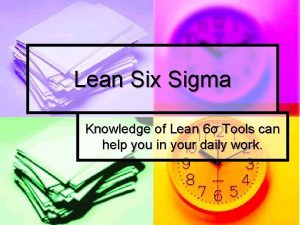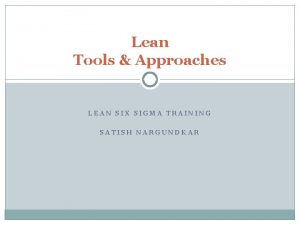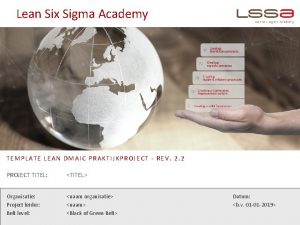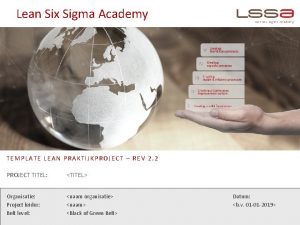Department of the Navy Lean Six Sigma Way



































- Slides: 35

Department of the Navy Lean Six Sigma Way Ahead Nick Kunesh Special Assistant to the Secretary of the Navy Lean Six Sigma 16 May 2007

The pillars of Business/Financial Transformation are the tools we’re employing to get a better return on our investment in people, processes, and systems. The Financial Improvement Program (FIP) focuses on heightening the quality of financial information. - Standardization and Internal Controls People - Measurement - Processes Financial Improvement Plan Navy ERP Better Resource Decisions LSS Performance Driven NSPS DON Business Transformation Systems Financial Improvement Program- Auditability and Internal Controls Accurate, Timely, and Transparent Financial Visibility 2

Do. N Total Obligation Authority (TOA) FY 07 Do. N Budget CVN-21 DDX LCS JSF MMA V-22 ACS LPD-17 EFV LHA(R) HLR FY 06 TOA $125. 6 B Procurement 26% RDT&E 13% $127. 3 B O&M 31% M&P 30% 65% is people 3

Ø Assign a CPI/LSS focal point to coordinate with the Do. D CPI/LSS Program Office. Ø Establish a 12 to 18 month workforce training objective of 1% LSS black belt trained and 5% green belt trained personnel. Personnel selected should include top-rated staff members. Ø Include CPI/LSS in individual employee performance objectives. Ø Provide support to the Do. D CPI/LSS Program Office in Do. Dwide process improvement initiatives. Ø Report progress and outcomes of ongoing and completed CPI/LSS projects and activities to the Do. D CPI/LSS Program 4 Office every 30 days initially.


SECNAV Lean Six Sigma Deployment Session 27 June 2006 SECNAV CNO Under SECNAV ACMC ASN (RD&A) ASN (M&RA) ASN (FM&C) ASN (I&E) DCMC (M&RA) DCMC (I&L) NAVSEA NAVAIR NAVSUP NAVFAC SPAWAR N 1 N 4 B N 80 DASN (Logistics) DASN (RDT&E) DASN (Environment) ADC (P&R) GC BUMED DNS CNI COO 6

Do. N Lean Six Sigma Three Year Action Plan Phase I Year 1 CY 06 Phase II Year 2 CY 07 Phase III Year 3 CY 08 Leadership • Leadership Kick-off and monthly progress meetings • Take XX% of overhead cost out of the Department • Balance process metrics across Do. N objectives & goals • Accelerate integration w/ industrial base and be • Plan for XX% reduction in overhead through CY 08 • NSPS SES / Flag fitness report bullet that recognizes LSS contributions • Accelerate the journey for those who have started (AIRSpeed, Task Force Lean, et. al. ) and report out financial results accountable for financial harvesting • Re-align to Do. N 07 objectives & goals, and measure LSS output to Do. N 06 objectives and goals • Take an additional XX% of overhead cost out of the Department • Re-align to Do. N 08 objectives & goals, and measure LSS output to Do. N 07 objectives and goals • Accelerate Enterprise maturity • All military and civilian performance evaluations and fitness reports recognize LSS contributions • Start the journey with enabling service, support and transactional functions (i. e. , FIN, HR, SC, IT, etc) Work Product • High impact core value streams are identified, mapped, and all applicable personnel are prepared to DMAIC • Accelerate Integration of organic Supply & Industrial Base with external suppliers (i. e. , private industry, DLA) • Identify where LSS applies to the Warfighter (i. e. , wargame planning & events) • High impact core value streams are DMAIC • High impact core value streams are revisited • Continuous Improvement of those activities that started • Service, support and transactional functions are in a before Jan 06 • 100% of all major Defense contracts awarded to industry will contain a LSS incentive clause Continuous Improvement closed loop • 25% of extended (with industry) value chains have been leaned out • Introduce Malcolm Baldrige criteria • Identify and clean legacy data bases for conversion to Navy ERP Education and Training • 1, 000 Black Belts certified • 1, 000 additional Black Belts • 2, 000 Green Belts certified • 4, 000 additional Green Belts • 25% of GS-15 /06 and above complete Champion training • 100% of GS-15 /06 and above complete Champion • Synchronize LSS training body of knowledge and training methods across the Do. N • Incorporate initial LSS training into all training schools (review Officer, Enlisted & Civilian career paths) training • Optimize LSS training across enterprise; BB/GB factory; (incorporate into 5 vector model) • Train additional Black Belts equal to 1% of affected workforce • Train additional Green Belts equal to 4% of affected workforce • 100% of GS-15 / 06 and above are LSS Champions • 5% of GS-15 / 06 and above are Green Belt certified 7

Phase I Year 1 CY 06 Leadership • Leadership Kick-off and monthly progress meetings • Balance process metrics across Do. N objectives & goals • Plan for XX% reduction in overhead through CY 08 • NSPS SES / Flag fitness report bullet that recognizes LSS contributions • Accelerate the journey for those who have started (AIRSpeed, Task Force Lean, et. al. ) and report out financial results • Start the journey with enabling service, support and transactional functions (i. e. , FIN, HR, SC, IT, etc) Work Product • High impact core value streams are identified, mapped, and all applicable personnel are prepared to DMAIC • Accelerate Integration of organic Supply & Industrial Base with external suppliers (i. e. , private industry, DLA) • Identify where LSS applies to the Warfighter (i. e. war-game planning & events) • Identify and clean legacy data bases for conversion to Navy ERP Education and Training • 1, 000 Black Belts certified • 2, 000 Green Belts certified • 25% of GS-15 /06 and above complete Champion training • Synchronize LSS training body of knowledge and training methods across the Do. N • Incorporate initial LSS training into all training schools (review Officer, Enlisted & Civilian career paths) 8

Phase II Year 2 CY 07 Leadership • Take XX% of overhead cost out of the Department • Accelerate integration w/ industrial base and be accountable for financial harvesting • Re-align to Do. N 07 objectives & goals, and measure LSS output to Do. N 06 objectives and goals • All military and civilian performance evaluations and fitness reports recognize LSS contributions Work Product • High impact core value streams are DMAIC • Continuous Improvement of those activities that started before Jan 06 • 100% of all major Defense contracts awarded to industry will contain a LSS incentive clause • Introduce Malcolm Baldrige criteria Education and Training • 1, 000 additional Black Belts • 4, 000 additional Green Belts • 100% of GS-15 /06 and above complete Champion training • Optimize LSS training across enterprise; BB/GB factory; (incorporate into 5 vector model) 9

Phase III Year 3 CY 08 Leadership • Take an additional XX% of overhead cost out of the Department • Re-align to Do. N 08 objectives & goals, and measure LSS output to Do. N 07 objectives and goals • Accelerate Enterprise maturity Work Product • High impact core value streams are revisited • Service, support and transactional functions are in a Continuous Improvement closed loop • 25% of extended (with industry) value chains have been leaned out Education and Training • Train additional Black Belts equal to 1% of affected workforce • Train additional Green Belts equal to 4% of affected workforce • 100% of GS-15 / 06 and above are LSS Champions • 5% of GS-15 / 06 and above are Green Belt certified 10


SECNAV’s Guidance for Senior Executive’s Performance Align Leadership Expectations With Workforce Accountabilities SECNAV Values Leaders Who… • Excel At Business / Process Improvement • Deliver Solutions At Best Cost • Are Change Agents • Lead Based On Insightful Metrics • Use LSS To Improve • Cascade / Measure SECNAV Guidance Penetration Throughout Organizations 12

SECNAV SMR FEEDBACK THE SECRETARY OF THE NAVY Washington DC May 08, 2007 MEMORANDUM FOR CHIEF OF NAVAL OPERATIONS COMMANDANT OF THE MARINE CORPS ASSISTANT SECRETARIES OF THE NAVY GENERAL COUNSEL SUBJECT: SECNAV Monthly Review (SMR) – Feedback from 4 May Session Thank you for the significant effort that you and your organizations have put into the SMR. All are making progress towards depicting Department of the Navy (DON) activities and programs in an understandable way, with clear indicators of priority and value. In particular, your listings of the “Top 5 Concerns” help focus our collective efforts to take future, meaningful action. I would like to discipline our discussions to center on the most significant issues, those of near-term interest as well as those of overall importance to the DON. I would encourage each of you to use the SMR forum to help assemble a cogent picture of the multi-faceted issues we face together. I asked you last month to improve metrics, and many improvements are evident. Navy is commended for their progress in the Warfare Enterprise areas, clearly the product of hard work and careful analysis. Marine Corps depiction of Readiness is comprehensive and intuitive. ASN (RD&A) milestone charts place key points in context and timescale. ASN (FM&C) depicted complex reprogramming actions in an easily understandable way. In as many areas as possible, metrics and measures used at the SMR should be built on an “information” basis, assembling or depicting data in a structured way that builds insight. Continue to focus efforts on metric improvements in this regard for the next session. The improvements in DON metrics adds to the “measure” step in the DMAIC process which underpins SMR. Continue to press your organizations to improve SMR based on our individual discussions last month. Though the turn-around is quick, I would ask you to reflect our agreements in the June SMR reports. As much as possible, I ask you to address the “Top 5 Concerns” by ensuring that the strategy to improve each one is clearly depicted in the SMR with its accompanying metrics. Many of the “Top 5” concerns should also be addressed using Lean Six Sigma (LSS) precepts, either for the effort itself or for its underlying processes. Where that is the case, the LSS effort should be clearly depicted, as well. Several good examples were discussed in the latest session: Navy efforts in SEAL recruiting and training; ASN (M&RA) Comprehensive Casualty Care; Marine and ASN (RD&A) efforts in delivering Mine Resistant Ambush Protected (MRAP) vehicles. I want to understand how you are using LSS to move your organizations forward. To that end, LSS reporting should continue to document training progress to support our reporting responsibilities to OSD in the Do. D enterprise LSS effort. High Impact Core Value Streams should also continue to be reported. Details of those Lean Six Sigma efforts should be clearly depicted in the SMR report, either in the separate LSS section or in the details of the reporting of the activity, as best suits. Underutilized Green and Black Belts should be assigned to Lean Six Sigma activity relative to your “Top 5 Concerns” or our department goals and objectives. 13 Attachment (1) lists actions for specific organizations. Please find the best approach to address them before our next session on 15 June. The SIPRNet SMR Quickplace web-site is populated with the May SMR report, as well as archived reports from previous months for your personal use. Please contact Mr. Griffes, Mr. Ferko, or Mr. Tesch for further assistance. Donald C. Winter

CNO Guidance for 2007 2 February 2007 F o c u s o n E x e c u tio n Each objective will be pursued using discrete, measurable goals. The accountable Executive Agent is listed: “Develop effective business strategies for the day-to-day management of Navy processes through the use of Lean Six Sigma and other business practices (DNS)" The Director of Navy Staff will develop an execution plan for the achievement of this objectives within 60 days. The Vice Chief of Naval Operations will review and approve the execution plan. 14

Lean Six Sigma Champions Trained or Scheduled % of Direct Reports and 1 st Tier 92% (average) Secretary of the Navy 100% Under Secretary of the Navy 100% ASN (RD&A) 100% ASN (M&RA) 100% ASN (FM&C) 74% CNO ASN (I&E) 100% OGC 90% CMC 8 Dec 06 15

Do. N Lean Six Sigma (LSS) Journey SECNAV Directs roll-out across all Do. N Service, Support and Transactional Activities. Do. D Senior Leadership Directs Use of LSS ASN RD&A Directs Use of LSS 2007 2006 2005 Navy and USMC Industrial Base Demonstrates Output From LSS 2004 2003 TQL/TQM ISO 9000 2002 2001 2000 1999 1990 NAVAL AVIATION ENTERPRISE Transactional Projects Yield Output LEAN Events on Three AIRCRAFT CARRIERS DEPOTS and SHIPYARDS COMMENCE LEAN NAVSEA Task Force Lean NAVAIR HQ AIRSPEED 16

Transformational Team Leaders (TTL) Forum LSS Network DON LEAN SIX SIGMA Team and Process Flow Education & Training WG RDML Skinner NAVAIR WG #1 CNO RD&A UNDER Financial Harvesting WG Jim Brice, SES NAVSEA WG #2 CMC TTL Chair Nick Kunesh SECNAV SA, LSS M&RA FM&C I&E GC WG #3 WG #5 Metrics WG CAPT Snedeker SECNAV OPA WG #4 Tools WG CAPT Stabile NAVAIR Communications WG Steve Santos, GS-15 NAVSUP Four Outputs: 1. Knowledge Based Sharing 2. Training Standardization 3. Roll Out Scalability 4. Financial Harvesting 17

FWG Membership Executive Leader: Value Stream Champion Mr. Nick Kunesh, SECNAV SA Ms. Caral Spangler ASN (FM&C) Team Leader: Black Belt: Mr. Jim Brice, SEA TFL Ms. Chris Cummings, NAVAIR Team Members Sally Reams, ASN (FM&C) David Van. Dornick, Mike Hansley, Susan Yang, NAVSEA Capt. Bob Novak, NAVAIR Dale Criswell, NAVSUP Bob Kamensky, Greg Hansford, Tom Straughn, SPAWAR Dave Clifton, Pat Lynch, USMC Katherine Clark, NAVAUDSVC Carla Moore, PEO(IS) Gary Younes, DASN (CHR)/OCHR Cdr. Duane Schatz, Junius Wright, (ONR) Oscar Friedman PEO(LMW) Capt Chuck Mingonet, Cdr Steve Evans, OPNAV N 8 Gloria Tuck, OPNAV N 4 Heidi Bopp, ASN(M&B) 18

Benefits Categorization Types 1, 2, and 3 (Phase 1) • Type 1: Permanent cost reduction identified to BLI(s) (Hard Savings)* – Example: Elimination of non-labor cost; reduced CSS Support; elimination of whole work-year(s) and associated billets • Type 2: Potential cost reduction from decreased cycle times or improved equipment/space utilization (Soft Savings)* – Example: Improved resource utilization to produce a product (work-year reduction, but does not eliminate a billet, improved capital equipment utilization, partial footprint reduction) • Type 3: Other benefits (Cost Avoidance)* – Example: Improves safety, customer satisfaction, quality, and work-life. No financial validation required *(Industry Equivalent Terms) 19

Project Charter Pre -Launch Financial Benefits Validation Process – Phase 1 Define Measure Analyze Improve Control (R/A) Updates DMS Start DC Validate End (R) Projects Financial Benefits & Enters project into DMS (R/A) Updates DMS (R) Examines expected benefits during define phase. Reviews/ updates project charter. Ensures benefits are realistic. Belt (R) Calculates and completes initial FBW (as-is) baseline data (DMS Metric 2) (R) Updates project charter benefit estimate if root cause analysis results in any change. (R) Requests FR from SFL (Electronically) (R) Updates FBW (Non. Recurring and To-Be Costs) (DMS Metric 2) (R) Contacts FR for planning purposes (R) Completes FBW with Manpower and BLIs (DMS Metrics 3&5) (R) Prints out FBW and the “FR Documentation of Review Sheet” and brings to TG. (R) Electronically notifies FR of FBW to be reviewed/validated early in Control Phase. (NLT 2 weeks before tollgate) PS (R) Identifies the appropriate FSME and informs FSME and Belt (R/A) Notifies Customers of Financial Impact to BLIs (R) Reviews charter for familiarization. FR FSME (R) Validates Financial Benefits (Locks Actuals in DMS) (R) Reviews project charter and assigns FR. Informs Belt, FR, PS and DC. SFL CLFR (R) Reviews FBW and inserts comments on the “FR Documentation of Review Sheet”. (Locks Estimate in DMS) (R/A) Validates Process and Financial Benefits Key: DC Deployment Champion (Lean Champion) PS Project Sponsor (Value Stream Champion) FR Financial Representative (Independent Reviewer) SFL Site Financial Lead CLFR Command Level Financial Rep FSME Financial Subject Matter Expert Assists Belt with compilation of financial information (R/A) consolidates & reports Command Type 1 & Type 2 Benefits

Leveraging Financial Benefits – Phase 2 Execution Year Budget Year Start CLFR 1 B Disseminates Type 1 Benefits by BLI for all Fiscal Years and identifies as Type A or B PBIS Report Key: CLFR: Command Level Financial Rep PM: Program Manager/Responsible Manager PEO: Program Executive Officer Ent: Enterprise FMB: Navy Comptroller (ASN/FM) CNO/CMC Chief of Naval Operations /Commandant Marine Corps (OPNAV) 1 A PM/PEO/ OPBUD HOLDERS Enterprise: Provider or Fleet Readiness Enterprise is defined as follows: PM/PEO Reprioritizes and Reprograms Type 1 A Benefits in YOE PM/PEO Informs Appropriate Enterprise and CNO of Benefits Enterprise Informed of BY Benefits CNO/CMC ACMC, DC PROG & RES. FMB Out years CNO/CMC Informed of outyear benefits FMB Approves via normal BTR or ATR process For Navy: Fleet Readiness Enterprise for Current Readiness and Provider Enterprise for Future Capabilities & Support of Current Readiness. For MC: Deputy Commandants, MARFOR Commanders, Commander MCSC and Director C 4 I. Enterprise keeps Book on BY Benefits - Offsets Congressional Reductions or Holds for Execution Year Enterprise Reprioritizes & Reprograms and Informs CNO/CMC Informed FMB Approves via normal BTR or ATR Process CNO/CMC Prioritizes & Structures Budget in POM Years

22

Department of the Navy Lean Six Sigma Density & Event Metrics As of Feb 07

Standardization of Definitions Standardize the terminology of specific CPI programs Do. N definitions have been approved for Lean, Six Sigma, Theory of Constraints (TOC) and Kaizen. Lean: A systematic methodology for continuous process improvement based on the principles of customer value, waste elimination, and pursuit of process perfection. Lean is unique from traditional process improvement strategies in that its primary focus is on eliminating nonvalue added activities and creating flow and pull in the value added activities. A major result of Lean is an improvement in cycle time. Lean attacks waste. Six-Sigma: A systematic methodology for process improvement that focuses on reducing variation, producing highly repeatable processes, and creating customer satisfaction. Six-Sigma utilizes the Define-Measure-Analyze-Improve-Control (DMAIC) methodology to make process change through disciplined use of facts, data, and statistical analysis and control of existing processes. It also includes an understanding of customer needs and diligent attention to managing, improving, and reinventing business processes. Six-Sigma attacks variation. Theory of Constraints (TOC): A systematic approach to optimize resource utilization by identifying, exploiting, subordinating, elevating and reassessing constraints in the process. Scientific principles are applied as a set of logical thinking processes to develop transformational, breakthrough business solutions. A constraint is any resource whose capacity is less than the demand placed upon it. TOC attacks constraints and barriers (a restriction or other block to increases in output). Kaizen (also known as “Kaizen Event”): A Japanese term meaning “Continuous Improvement”. In Lean Six-Sigma terms, it refers to a highly focused, short-term rapid improvement event performed by cross-functional teams at the work-group level that identifies and removes waste from a process. Good Kaizen events follow the Define-Measure-Analyze-Improve-Control (DMAIC) recipe, can be performed quickly (usually less than two months), and involve the use of basic Lean Six-Sigma tools to implement process improvement solutions. Kaizen is focused on rapid improvement. 24

Standardize Do. N certification process for Black Belt Training Certification Process (Approved) Teaching/ Training Testing Projects Mentoring Other Min 160 hrs over min four (4) weeks covering Navy-wide Body of Knowledge (BOK) including project work Comprehensive (to BOK) Training Completion Test with >75% passing score and allowance for one (1) retest. Do. N ASQ Certification Exam encouraged. Successful (signed off final tollgate) completion of: two (2) LSS Full DMAIC projects minimum 3 -6 month projects and one (1) RIE/ KAIZEN event Mentor two (2) GBs through one project each or three (3) RIEs/KAIZENs for each Certification by each Command's Head of LSS Office or Approval Board Green Belt Training Certification Process (Approved) Mentoring Training Min 40 hrs covering Navy-wide BOK for GBs including project work Testing Projects Comprehensive (to BOK) Training Completion Test w/ >75% passing score and allowance for one (1) retest. Successful (signed off final tollgate) completion of: two (2) LSS Full DMAIC projects (minimum 2 -4 month); or four (4) RIEs/ KAIZENs; or one (1) LSS and three (3) RIEs/ KAIZENs Other None Certification by each Command's Head of LSS Office or Approval Board 25

Do. N/ASQ Lean Six Sigma (LSS) Black Belts 26

Lean Six Sigma Software Tools • i. Grafx Process for Six Sigma – LSS expert/Black Belt/Green Belt process mapping and analysis tool – Optimizes processes via modeling and simulation capability – Captures knowledge (value stream and process maps) for sharing and enabling replication • Minitab – Statistical software designed to support Lean Six Sigma and other quality improvement projects – Integrates seamlessly with i. Grafx • Deployment Management System (DMS) – Web-based application for managing enterprise-wide Lean Six Sigma deployment – Currently in Phase I deployment at NAVAIR 27

Lean Six Sigma Improvements for CVN-21 Milestone B 28

CVN-21’s Milestone B Documentation Effort TEMP 7 CVN-21 MS B documents analyzed: ILA Man-hours expended: 245, 742 Ø Total cost: $18. 4 M Total review touch points: 6, 952 LFT&E CARD Ø Non value add (NVA) touch points: 6, 654 Ø 56 different organization ‘touch-points’ Ø Average number of organizations touched per document = 22 VAR II Ø NVA cost: $11. 171 M (96%) PLCCE Ø NVA man-hours: 148, 939 C 4 ISR Team’s Perspective $11. 17 M NVA touch points Note: Above data based on CVN-21 Milestone B complexity analysis. NVA determined from CVN-21 team perspective. 29

CVN-21’s Milestone B TEMP Time and Motion Study TEMP Doc Data Summary § Queue Time: included in NVA routing + 26 days for approvals § Total Man-hours: 16, 612 § Total Cost: $1. 246 M § Total Arrows: 377 § VA = 47 (12%) § NVA = 330 (88%) § NVA Cost = $1. 091 Note: Arrows represent review loops, red are non value added, black are value added.

Justification and Approval (J&A) Process Rapid Improvement Event Goal: Reduce J&A flow time and rework; increase review time flexibility Current State Analysis Future State Solution • • • • 41 day average flow time 51 Hand offs 1% first pass yield 40% submitted electronically Five serial reviews 5. 4 day average flow time 11 Hand offs 74% first pass yield 100% submitted electronically Three serial reviews Streamlined process Increased automation -all reviews electronic --instant receipt notification Reduced serial reviews / rework Content requirements communicated to SYSCOM; submittal templates created 31

Justification and Approval (J&A) Process Rapid Improvement Event/Value Stream Mapping

BFMC Lean Pilot Solution Outcome Reimbursable Funding Documents to NAVAIR Field Activities Pre-VSA State Current State Solution • 30 plus steps (all serial) • 16 queues • 8 work-arounds • Multiple hard copies • 12 review and approval steps • 28 day average processing time • 15 steps (4 performed concurrently) • 4 queues • No work-arounds • Fewer hard copies • 5 review and approval steps • 4 day average processing time • Moved downstream activities up front • Brought all parties to table – expanded IPT • Removed WAIT time (queues) • Ensured complete and accurate product early • Reduced rework/rejects • Leveraged ERP ensuring all financial links match project plan to performing activity 33

Summer Hire Process NAVAIR AIRSpeed Type Study: KAIZEN Goal: Streamline and reduce costs of summer hire program Pre-VSA State Current State • • • 4, 000 man hours expended to execute process 24 Process Steps 70 day Process Cycle Time $12. 8 K per recruit Voice of Customer not identified • • 1, 000 man hours expended to execute process 4 process Steps 45 day Process Cycle Time $2. 4 K per recruit Voice of Customer integrated Savings: One man-year in labor, faster, simpler, customer friendly 34

SECNAV Congressional Response Process Kaizen Project Problem/Goal Statement Business Impact Problem: Currently Department of Navy Congressional Responses are not meeting internal Navy cycle time requirements of 7 work days and the quality of the responses is not consistent. SECNAV has established the ASN (I&E) project as a prototype for replication purposes. Since the beginning of 2006, the mean ASN (I&E) Process Cycle Time has been 17. 8 work days. • Scope: The scope of this project will include the response categories of: Congressional Constituent, Congressional Member of Congress. Goal: Decrease the mean Process Cycle Time from 17. 8 to 7 work days. • Financial Impact – – Type I Savings – none anticipated at this time Type II Savings – TBD Non-Quantifiable Benefits – Better customer relations with Congress Core Team • Dr. Donald Winter Project Sponsor/Process Owner/Green Belt • CDR Jim Aiken Deployment Champion • Phil Zalesak Black Belt • Steve Bonacorsci Master Black Belt Core Team Role LSS Training • LT Ball SME Yellow Belt • Catherine Timco SME Yellow Belt • YN 1 Suggs SME Yellow Belt • Alan Anglin SME Yellow Belt • Jim Ives SME Yellow Belt • Denise Brown SME Green Belt • Oral John SME Green Belt Extended Team • TBD (ASN I&E) Timeline Event Date • Initial tasking 7/6 • Scoping 7/17 – 8/23 • Kaizen preparation 8/24 – 9/9 • SECNAV Brief 9/12 • Kaizen 9/18 – 9/21 • Implementation 10/2 35
 Lean six sigma navy
Lean six sigma navy Who is this
Who is this Six sigma forum
Six sigma forum Dmaic storyboard
Dmaic storyboard Charter lean six sigma
Charter lean six sigma Human resources six sigma
Human resources six sigma Lean six sigma nedir
Lean six sigma nedir Six sigma foundations
Six sigma foundations Carl bergeron
Carl bergeron Lego six sigma
Lego six sigma Control plan lean six sigma
Control plan lean six sigma Six sigma foundations
Six sigma foundations Six sigma storyboard
Six sigma storyboard Six sigma foundations download
Six sigma foundations download Department of the navy
Department of the navy Department of the navy chief information officer
Department of the navy chief information officer Sigma lean sgrho
Sigma lean sgrho Sigma sigma phi vcom
Sigma sigma phi vcom Edward via college of osteopathic medicine auburn
Edward via college of osteopathic medicine auburn Poka-yoke
Poka-yoke Lean six
Lean six Cmmi six sigma
Cmmi six sigma Microsoft six sigma
Microsoft six sigma Explain the importance of tollgates in the dmaic process
Explain the importance of tollgates in the dmaic process Statapult exercise instructions
Statapult exercise instructions Six sigma qualtec
Six sigma qualtec Six sigma kpiv
Six sigma kpiv Mse six sigma
Mse six sigma Six sigma belts hierarchy
Six sigma belts hierarchy Statistics symbols cheat sheet
Statistics symbols cheat sheet Measurement system analysis
Measurement system analysis Pilot plan template six sigma
Pilot plan template six sigma Six sigma checklist
Six sigma checklist Mse six sigma
Mse six sigma Iso 9000 vs six sigma
Iso 9000 vs six sigma Six sigma kanban
Six sigma kanban
